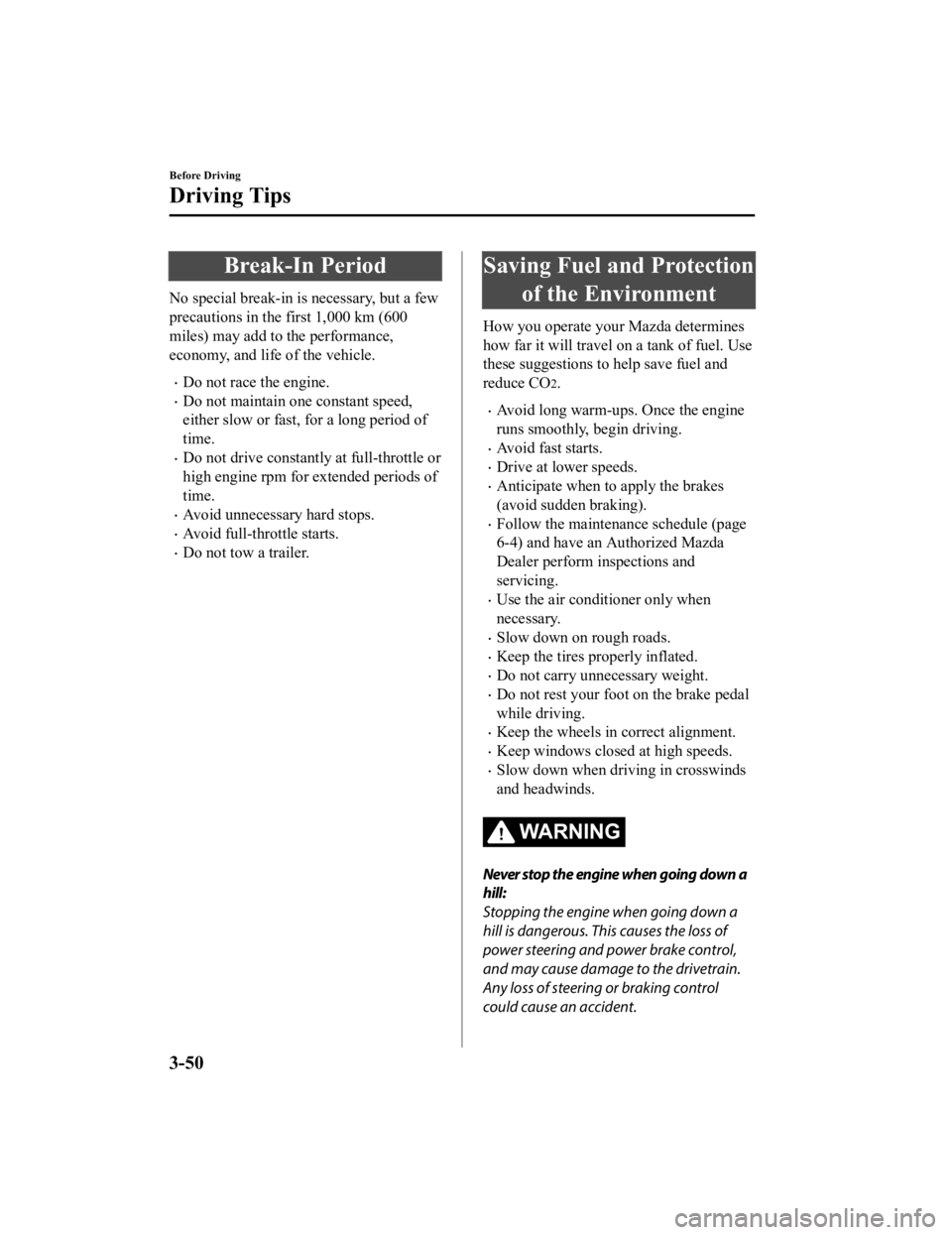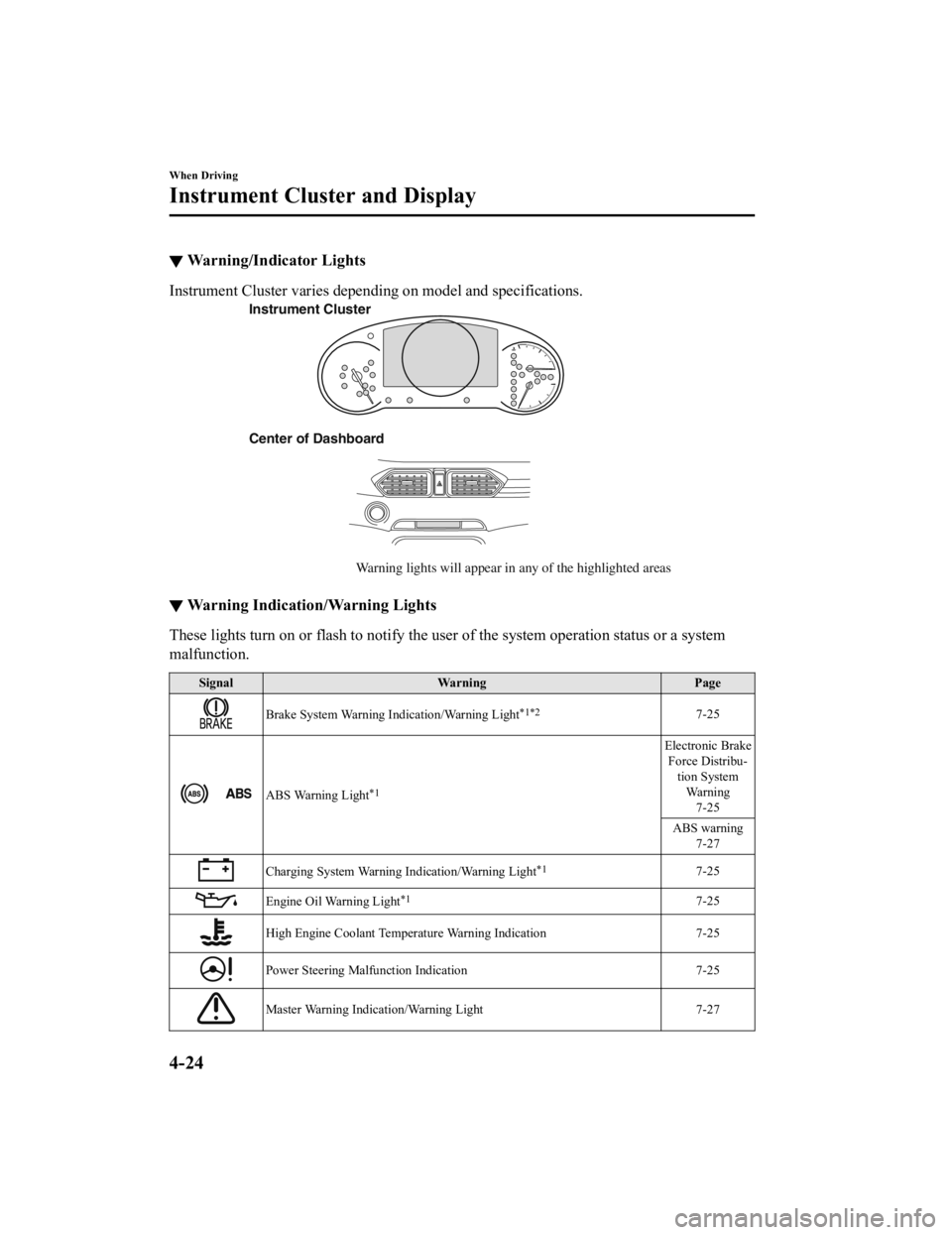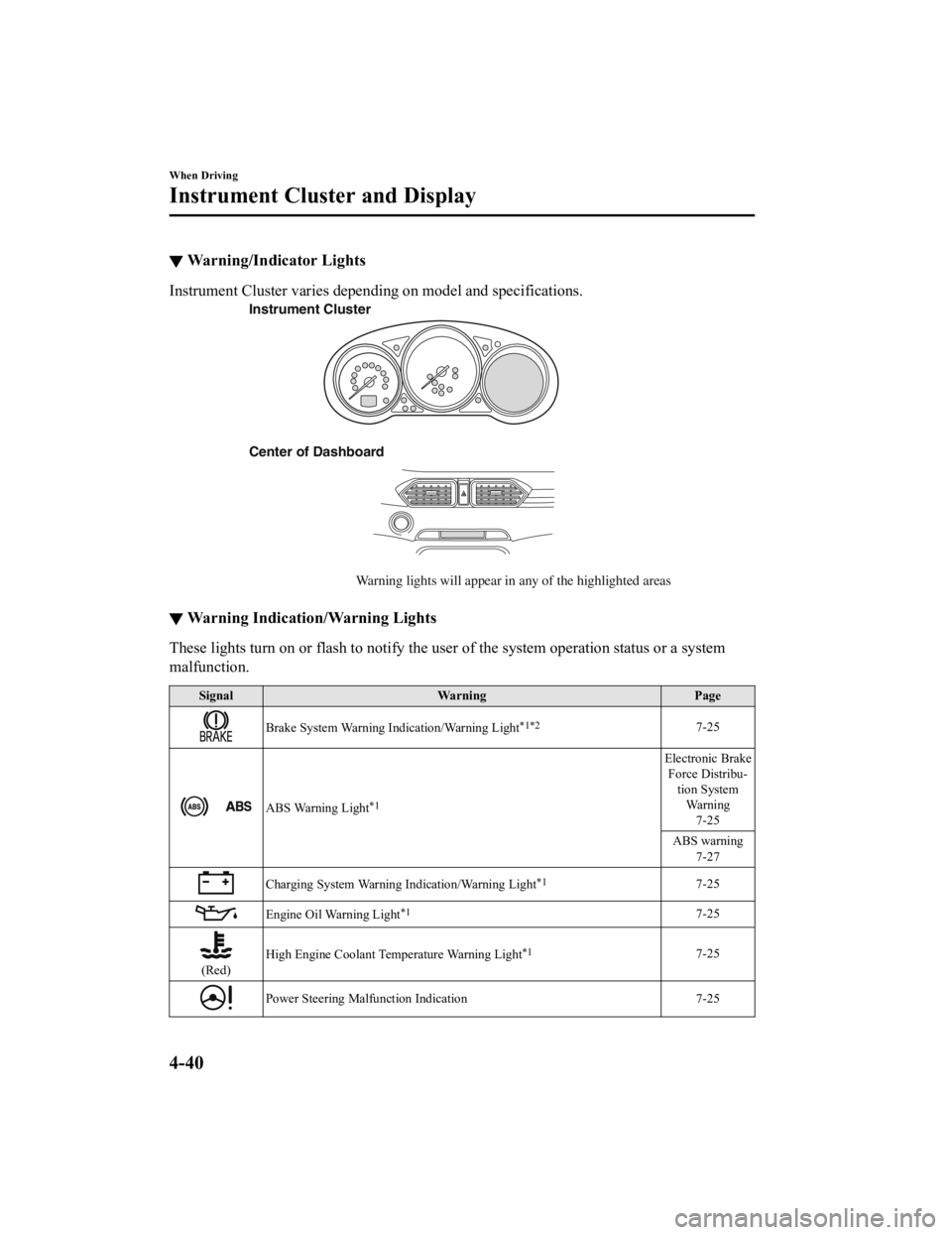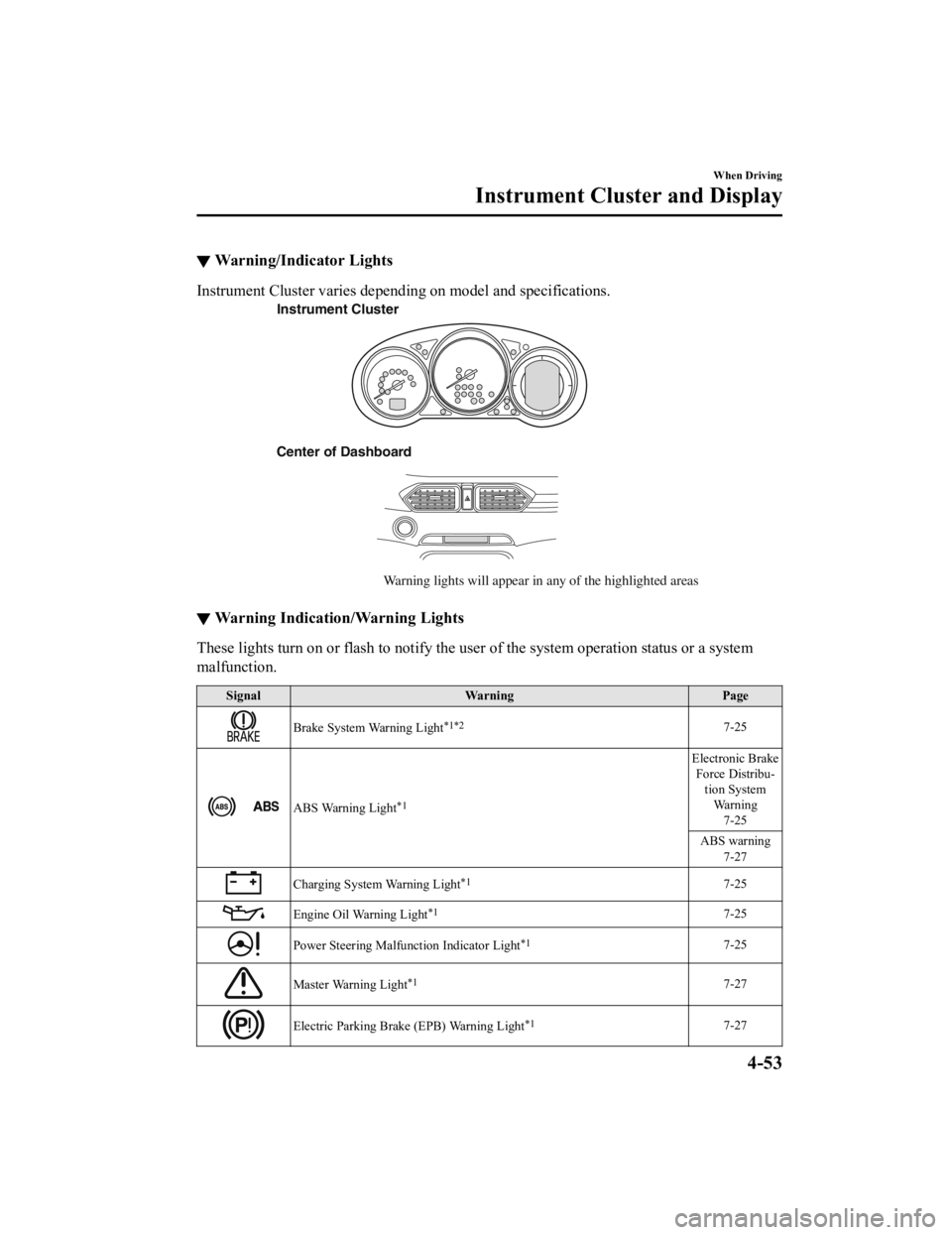steering MAZDA MODEL CX-5 SKYACTIV-D 2019 User Guide
[x] Cancel search | Manufacturer: MAZDA, Model Year: 2019, Model line: MODEL CX-5 SKYACTIV-D, Model: MAZDA MODEL CX-5 SKYACTIV-D 2019Pages: 721, PDF Size: 97.68 MB
Page 72 of 721

Never use a rear-facing child-restraint system in the front seat with an air bag that could
deploy:
Rear-facing child-restraint systems on the front seat are particularly dangerous even though
you may feel assured that a front passenger air bag will not deploy based on the fact that the
front passenger air bag deactivation indicator light illuminates. The child-restraint system
can be hit by a deploying air bag and moved viol ently backward resulting in serious injury or
death to the child.
Do not sit too close to the driver and front passenger air bags:
Sitting too close to the driver and front passenger air bag modules or placing hands or feet on
them is extremely dangerous. The driver and fron t passenger air bags inflate with great force
and speed. Serious injuries could occur if some one is too close. The driver should always hold
onto only the rim of the steering wheel. The front seat passenger should keep both feet on the
floor. Front seat occupants should adjust their seats as far back as possible and always sit
upright against the seatbacks wi th seat belts worn properly.
Sit in the center of the seat and wear seat belts properly:
Sitting too close to the side air bag modules or placing hands on them, or sleeping up against
the door or hanging out the windows is extr emely dangerous. The side and curtain air bags
inflate with great force and speed directly expand ing along the door on the side the car is hit.
Serious injury could occur if someone is sitting too close to the door or leaning against a
window, or if rear seat occupants grab the side s of the front seatbacks. Give the side and
curtain air bags room to work by sitting in th e center of the seat while the vehicle is moving
with seat belts worn properly.
Do not attach objects on or around the area where driver and front passenger air bags
deploy:
Attaching an object to the driver and front passenger air bag modules or placing something
in front of them is dangerous. In an accident , an object could interfere with air bag inflation
and injure the occupants.
Essential Safety Equipment
SRS Air Bags
2-58
CX-5_8HH4-EA-19A_Edition1 2018-11-21 10:03:20
Page 75 of 721

Do not place luggage or other objects under the front seats:
Placing luggage or other objects under the front seats is dangerous. The components
essential to the supplemental restraint system could be damaged, and in the event of a side
collision, the appropriate air bags may not de ploy, which could result in death or serious
injury. To prevent damage to the components essential to the supplemental restraint system,
do not place luggage or other objects under the front seats.
Do not operate a vehicle with damaged air bag/seat belt pretensioner system components:
Expended or damaged air bag/seat belt preten sioner system components must be replaced
after any collision which caused them to deploy or damage them. Only a trained Authorized
Mazda Dealer can fully evaluate these systems to see that they will work in any subsequent
accident. Driving with an expended or dama ged air bag or pretensioner unit will not
afford
you the necessary protection in the event of any subsequent accident which could result in
serious injury or death.
Do not remove interior air bag parts:
Removing any components such as the front seats, front dashboard, the steering wheel or
parts on the front and rear window pillars and along the roof edge, containing air bag parts
or sensors is dangerous. These parts contain essential air bag components. The air bag could
accidentally activate and cause serious injuri es. Always have an Authorized Mazda Dealer
remove these parts.
Properly dispose of the air bag system:
Improper disposal of an air bag or a vehicle with live air bags in it can be extremely
dangerous. Unless all safety procedures are followed, injury could result. Have an Authorized
Mazda Dealer safely dispose of the air bag sy stem or scrap an air bag equipped vehicle.
NOTE
If it becomes necessary to have the components or wiring system for the supplementary
restraint system modified to accommodate a person with certain medical conditions in
accordance with a certified physician, contact an Authorized Mazda Dealer, refer to
“Customer Assistance (U.S.A.)” (page 8-2).
When an air bag deploys, a loud inflation noise can be heard and some smoke will be
released. Neither is likely to cause injury, however, the texture of the air bags may cause
light skin injuries on body parts not covered with clothing through friction.
Should you sell your Mazda, we urge you to tell the new owner of its air bag systems and
that familiarization with all instructi ons about them, from the Owner's Manual, is
important.
Essential Safety Equipment
SRS Air Bags
2-61
CX-5_8HH4-EA-19A_Edition1 2018-11-21 10:03:20
Page 79 of 721

How the SRS Air Bags Work
Your Mazda is equipped with the following types of SRS air bags. SRS air bags are
designed to work together with the seat belts to help to reduce injuries during an accident.
The SRS air bags are designed to provide further protection for passengers in addition to the
seat belt functions. Be sure to wear seat belts properly.
▼ Front Seat Belt Pretensioners
The front seat belt pretensioner
s are designed to deploy in moderate or severe frontal, near
frontal collisions.
In addition, the pretensioners operate when a side collision or a roll-over accident is
detected. The pretensioners operate differently depending on what types of air bags are
equipped. For more details about seat belt pret ensioner operation, refer to the SRS Air Bag
Deployment Criteria (page 2-69).
▼ Driver Air Bag
The driver's air bag is mounted in the steering wheel.
When air bag crash sensors detect a frontal impact of greater than moderate force, the
driver's air bag inflates quickly
helping to reduce injury mainly to the driver's head or chest
caused by directly hitting the steering wheel.
For more details about air bag deployment, refer to "SRS Air Bag Deployment Criteria"
(page 2-69).
(With Front Passenger Occupant Classification System)
The driver's dual-stage air bag controls air bag inflation in two energy stages. During an
impact of moderate severity, the driver's ai r bag deploys with lesser energy, whereas during
more severe impacts, it de ploys with more energy.
Essential Safety Equipment
SRS Air Bags
2-65
CX-5_8HH4-EA-19A_Edition1 2018-11-21 10:03:20
Page 142 of 721

Break-In Period
No special break-in is necessary, but a few
precautions in the first 1,000 km (600
miles) may add to the performance,
economy, and life of the vehicle.
Do not race the engine.
Do not maintain one constant speed,
either slow or fast, for a long period of
time.
Do not drive constantly at full-throttle or
high engine rpm for extended periods of
time.
Avoid unnecessary hard stops.
Avoid full-throttle starts.
Do not tow a trailer.
Saving Fuel and Protectionof the Environment
How you operate your Mazda determines
how far it will travel on a tank of fuel. Use
these suggestions to help save fuel and
reduce CO
2.
Avoid long warm-ups. Once the engine
runs smoothly, begin driving.
Avoid fast starts.
Drive at lower speeds.
Anticipate when to apply the brakes
(avoid sudden braking).
Follow the maintenance schedule (page
6-4) and have an Authorized Mazda
Dealer perform inspections and
servicing.
Use the air conditioner only when
necessary.
Slow down on rough roads.
Keep the tires properly inflated.
Do not carry unnecessary weight.
Do not rest your foot on the brake pedal
while driving.
Keep the wheels in correct alignment.
Keep windows closed at high speeds.
Slow down when driving in crosswinds
and headwinds.
WA R N I N G
Never stop the engine when going down a
hill:
Stopping the engine when going down a
hill is dangerous. This causes the loss of
power steering and power brake control,
and may cause damage to the drivetrain.
Any loss of steering or braking control
could cause an accident.
Before Driving
Driving Tips
3-50
CX-5_8HH4-EA-19A_Edition1 2018-11-21 10:03:20
Page 156 of 721

Passing
Plan well ahead to pass other vehicles, and provide plenty of room before changing lanes.
Crosswinds from passing vehicles, especially larger ones, and the effects of rough roads will
affect handling.
If swaying occurs, firmly grip the steering wheel and reduce speed immediately, but
gradually.
Steer straight ahead. If no extreme correc tion of steering or braking is made, the
combination of less speed and firm steering will result in stability.
Backing up
Backing a vehicle with a trailer requires practice and patience. Back slowly, and have a
helper outside at the rear of the trailer to reduce the risk of an accident.
To turn the trailer, place your hand at the bott om of the steering wheel and turn it in the
direction you want the trailer to go. Make only slight movements to prevent sharp or
prolonged turning.
Ascending a hill
Shift into a lower gear to redu ce the possibility of overloading or overheating the engine, or
both.
Descending a hill
Shift into a lower gear and use engine compression as a braking effect.
WA R N I N G
Always use lower gears to reduce speed:
Holding the brake pedal down too long or too f requently is dangerous as it could cause the
brakes to overheat and lose power, resulting in loss of control and a serious accident. Use
lower gears to help reduce speed. Pull off th e road and allow brakes to cool down whenever
braking performance feels reduced.
Overheated engine
The extra weight of the trailer may strain the engine on hot days and on long or steep
upgrades.
If the temperature gauge indicates overheating, turn off the air conditioner, drive safely to
the side of the road, park of f the right-of-way and wait for engine to cool. Refer to
Overheating on page 7-19.
Before Driving
To w i n g
3-64
CX-5_8HH4-EA-19A_Edition1 2018-11-21 10:03:20
Page 157 of 721

Parking
Always make sure the tires of the trailer and the tow vehicle are blocked while parked.
Apply the parking brake firmly and put the transaxle in P.
Avoid parking on an incline, but if you must, follow these instructions:
1. Depress and hold down the brake pedal.
2. Have a helper put wheel blocks against the downhill side of all vehicle and trailer tires.
3. Then release the brake pedal slowly until the blocks bear the load.
If the grade is downhill, turn the steering wheel so that the front of the front tires face
the curb.
If it is uphill, face the rear of the front tires against the curb.
4. Firmly apply the parking brake.
5. Shift the transaxle into P, and stop the engine.
To restart after parking on an incline:
1. With the transaxle in P, start the engine. (Be sure to depress and hold the brake pedal.)
2. Shift into gear.
3. Release the parking brake (also the foot brake) and pull away from the wheel blocks. Stop; apply the parking brake and shift into P.
4. Have a helper retrieve the wheel blocks.
Fuel consumption
Trailer towing causes higher fuel consumption.
Maintenance
If you tow a trailer frequently, have your vehicle serviced as shown in Scheduled
Maintenance (page 6-4).
Before Driving
To w i n g
3-65
CX-5_8HH4-EA-19A_Edition1 2018-11-21 10:03:20
Page 160 of 721

Drive Selection............................... 4-113Drive Selection
*........................4-113
i-ACTIV AWD............................... 4-115 i-ACTIV AWD Operation
*....... 4-115
Power Steering............................... 4-117 Power Steering..........................4-117
i-ACTIVSENSE............................. 4-118
i-ACTIVSENSE
*...................... 4-118
Adaptive Front Lighting System
(AFS)
*...................................... 4-121
High Beam Control System
(HBC)
*......................................4-122
Blind Spot Monitoring (BSM)
*.........
.................................................. 4-125
Traffic Sign Recognition System
(TSR)
*...................................... 4-130
Distance Recognition Support
System (DRSS)
*....................... 4-136
Rear Cross Traffic Alert (RCTA)
*.....
.................................................. 4-140
Mazda Radar Cruise Control with
Stop & Go function (MRCC with
Stop & Go function)
*............... 4-144
Lane-keep Assist System (LAS) &
Lane Departure Warning System
(LDWS)
*.................................. 4-158
Advanced Smart City Brake Support
(Advanced SCBS)
*...................4-169
Smart City Brake Support
(SCBS)
*.................................... 4-172
Smart Brake Support (SBS)
*.... 4-175
360° View Monitor
*................. 4-178
Forward Sensing Camera (FSC)
*......
.................................................. 4-205
Radar Sensor (Front)
*.............. 4-210
Radar Sensors (Rear)
*.............. 4-213
Front Camera/Side Cameras/Rear
Camera
*.................................... 4-215
Cruise Control............................... 4-216 Cruise Control
*.........................4-216
4-2*Some models.
CX-5_8HH4-EA-19A_Edition1 2018-11-21 10:03:20
Page 182 of 721

▼Warning/Indicator Lights
Instrument Cluster varies depending on model and specifications.
Center of Dashboard
Warning lights will appear in any of the highlighted areas
Instrument Cluster
▼
Warning Indication/Warning Lights
These lights turn on or flash to notify the user of the system operation status or a system
malfunction.
Signal
Warning Page
Brake System Warning Indication/Warning Light*1*27-25
ABS Warning Light*1
Electronic Brake
Force Distribu- tion SystemWa r n i n g 7-25
ABS warning 7-27
Charging System Warning Indication/Warning Light*17-25
Engine Oil Warning Light*17-25
High Engine Coolant Temperature Warning Indication 7-25
Power Steering Malfunction Indication 7-25
Master Warning Indication/Warning Light 7-27
When Driving
Instrument Cluster and Display
4-24
CX-5_8HH4-EA-19A_Edition1 2018-11-21 10:03:20
Page 198 of 721

▼Warning/Indicator Lights
Instrument Cluster varies depending on model and specifications.
Instrument Cluster
Center of Dashboard
Warning lights will appear in any of the highlighted areas
▼Warning Indication/Warning Lights
These lights turn on or flash to notify the user of the system operation status or a system
malfunction.
Signal
Warning Page
Brake System Warning Indication/Warning Light*1*27-25
ABS Warning Light*1
Electronic Brake
Force Distribu- tion SystemWa r n i n g 7-25
ABS warning 7-27
Charging System Warning Indication/Warning Light*17-25
Engine Oil Warning Light*17-25
(Red) High Engine Coolant Temperature Warning Light
*17-25
Power Steering Malfun
ction Indication 7-25
When Driving
Instrument Cluster and Display
4-40
CX-5_8HH4-EA-19A_Edition1 2018-11-21 10:03:20
Page 211 of 721

▼Warning/Indicator Lights
Instrument Cluster varies depending on model and specifications.
Instrument Cluster
Center of Dashboard Warning lights will appear in any of the highlighted areas
▼Warning Indication/Warning Lights
These lights turn on or flash to notify the us
er of the system operation status or a system
malfunction.
Signal Warning Page
Brake System Warning Light*1*27-25
ABS Warning Light*1
Electronic Brake
Force Distribu- tion SystemWa r n i n g 7-25
ABS warning 7-27
Charging System Warning Light*17-25
Engine Oil Warning Light*17-25
Power Steering Malfunction Indicator Light*17-25
Master Warning Light*17-27
Electric Parking Brake (EPB) Warning Light*17-27
When Driving
Instrument Cluster and Display
4-53
CX-5_8HH4-EA-19A_Edition1 2018-11-21 10:03:20